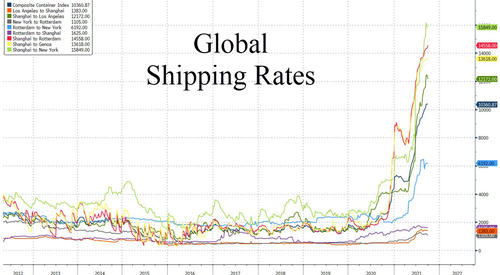Blames tangled-up supply chains but not what’s causing supply chains to get tangled up in the first place: The most grotesquely overstimulated economy ever.
Fed Chair Jerome Powell, during a panel discussion hosted by the ECB today, admitted again that inflation pressures would run into 2022 and blamed “bottlenecks and supply chain problems not getting better” and admitted they are “in fact at the margins apparently getting a little bit worse.”
“The current inflation spike is really a consequence of supply constraints meeting very strong demand, and that is all associated with the reopening of the economy, which is a process that will have a beginning, a middle and an end,” he said.
OK, good, he almost gets it: “very strong demand” is causing this. But where the heck does this “very strong demand” come from?
Here’s where: The most grotesquely overstimulated economy ever.
The Fed has handed out $4.5 trillion to investors in 18 months, and repressed short-term interest rates to near 0%, and long-term interest rates (via the $120 billion a month in bond purchases) to ridiculously low levels, and this has inflated asset prices, including home prices, and beneficiaries are feeling rich and flush, and they’re going out and borrowing against their assets and buying $70,000 pickup trucks, electronic devices, yachts, second and third homes, and a million other things. That’s where much of the demand comes from.
The other part of the demand comes from the government, which spread $5 trillion in borrowed money around over the past 18 months – stimulus checks, forgivable PPP loans (over $800 billion), extra unemployment benefits, funds sent to states to spend how they see fit, to airlines and other big companies to bail them out, which then used this money to buy out their employees that then spent this money.
…click on the above link to read the rest of the article…














